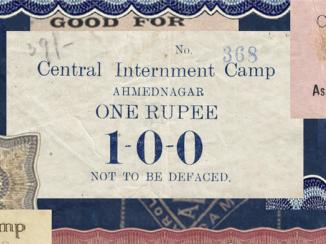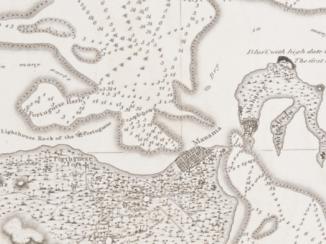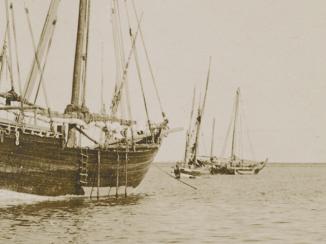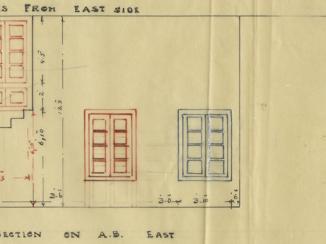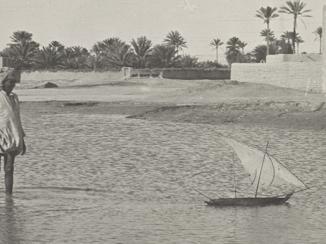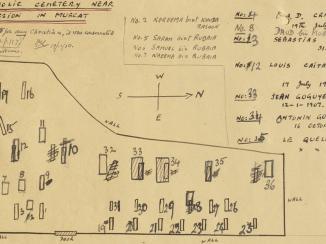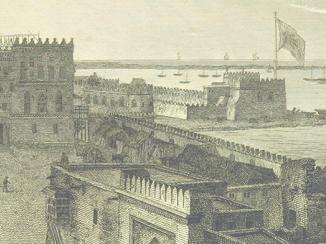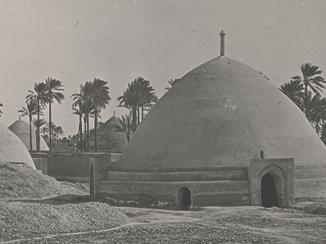Overview
History of British ships in the East
The first British ships in the Gulf and India were trading vessels belonging to the East India Company, or merchant ships with permits from the Company to trade in the region. However, in order to protect its interests, the Company soon wanted a permanent naval force, which was formed in India in the early seventeenth century. In 1686, this force was renamed the ‘Bombay Marine’, and it increased in size and significance during the struggles between the Bombay Presidency The name given to each of the three divisions of the territory of the East India Company, and later the British Raj, on the Indian subcontinent. and the Maratha Navy in the first half of the eighteenth century. The ships of the Bombay Marine The navy of the East India Company. were employed in the Gulf to protect British shipping, carry packets of letters, transport soldiers, and intimidate the local population. In 1830, the Bombay Marine The navy of the East India Company. became ‘His Majesty’s Indian Navy’, often abbreviated to ‘IN’. From 1863 to 1877, the force was again known as the Bombay Marine The navy of the East India Company. , and then became ‘Her Majesty’s Indian Marine’, before changing its name once more to ‘Royal Indian Marine’ in 1892.
The Gulf Squadron was commanded by the Senior Naval Officer in the Persian Gulf The historical term used to describe the body of water between the Arabian Peninsula and Iran. , who liaised with the Resident in the Persian Gulf The historical term used to describe the body of water between the Arabian Peninsula and Iran. , but was ultimately under the Commander of the Indian Navy in Bombay [Mumbai].
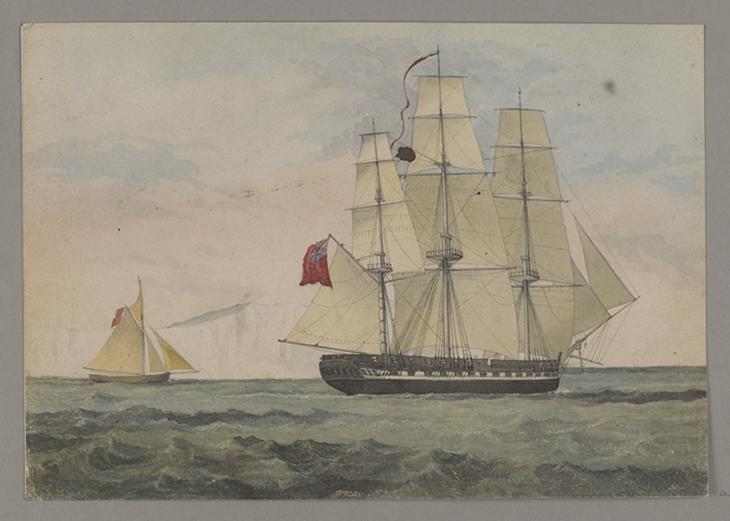
British vessels: their role
Many of the ships in the Gulf were merchants, but those mentioned in the India Office The department of the British Government to which the Government of India reported between 1858 and 1947. The successor to the Court of Directors. Records often had a more sinister role. They were used for “pacifying” the Gulf states, as well as protecting British merchantmen from European enemies. During the nineteenth century, there was a constant British naval presence in the Gulf, but usually only smaller ships were available for service there, unless there was a particular need for larger ones. Due to a shortage of ships, many were used for whatever service was necessary, whether it was their intended duty or not. The waters of the Gulf were shallow and squally, which meant that not all of the British vessels available were suitable for use. British designers created some new ship styles by adapting the local vessels they saw around them, which were better suited to the prevailing conditions.
Other European vessels
British ships were not the only European vessels in these waters; among others, the Dutch, French, and Portuguese navies all had fleets in the area. Where EIC records mention other ships, they often classify them as if they were British; for example, French ships are referred to under the same rating system as the British vessels, although the French navy itself used a different system.
Nomenclature of British vessels
Many British vessels include initials before their name, such as HMS. These initials are the ship prefix and relate to the ownership, type, and/or role of the ship. Where ship names are preceded by ‘HM’ or ‘HBM’, this stands for ‘His/Her Majesty’s’, or ‘His/Her Britannic Majesty’s’, and indicates that the ship was part of the Royal Navy. On the other hand, ‘HC’ stands for ‘Honourable Company’s’ and refers to an East India Company ship.
Types of European and American ships
While Europeans sailing in the Gulf frequently used and adapted local boats, the following types of vessel are those which were primarily of European design.
Barque or bark: This term originally referred to a large ship with three or more masts, two of them square-rigged, and a fore-and-aft rig on the mizzen (rearmost) mast. However, from the seventeenth century, any small vessel could be called a barque or bark.
Bomb Ketch: Armed with mortars for shore bombardment, these vessels were in practice often used simply as escort ships. Initially they were built with two masts, leaving the fore-deck clear for the mortars, but by the late eighteenth century they had three masts. Mortars fired explosive shells rather than solid shot, but their inaccuracy and lack of manoeuvrability meant that they were not employed against other ships.
Brig: A two-masted, square-rigged vessel. Additional fore-and-aft sails were fixed in front of the foremast. They existed before the seventeenth century, but became more common throughout the nineteenth century, and were used as cargo vessels and small warships. A brig typically carried between ten and eighteen guns, and was highly manoeuvrable.
Brigantine: This type of ship increased in size over time from a small square-sailed two-master to a larger ship with one square-rigged mast and another gaff-rigged. It was lightly armed, and often used for carrying dispatches.
Corvette: See below under Sloop of War
Cruiser: Often spelt cruizer, this refers to the purpose of the ship rather than its size or sail plan. It would be employed to cruise over a particular area, often to intercept enemy ships or to display naval strength, rather than to sail directly from one point to another.
Cutter: This refers to two different vessels. The first was single-masted with a gaff-rigged mainsail and square topsail, used for patrolling and carrying passengers and messages due to its speed. It carried between ten and twelve guns. The other was a boat carried on a ship, with a square stern and often propelled by oars, measuring twenty-four to thirty-two feet in length.
East Indiaman: A term for any merchant sailing ship trading under the licence of the East India Company, from the seventeenth to the nineteenth century. As they sailed from England to India, they were large, carrying about 1100-1400 tons, and lightly armed. They were often highly decorated and gilded until the end of the eighteenth century, when decoration became more moderate.
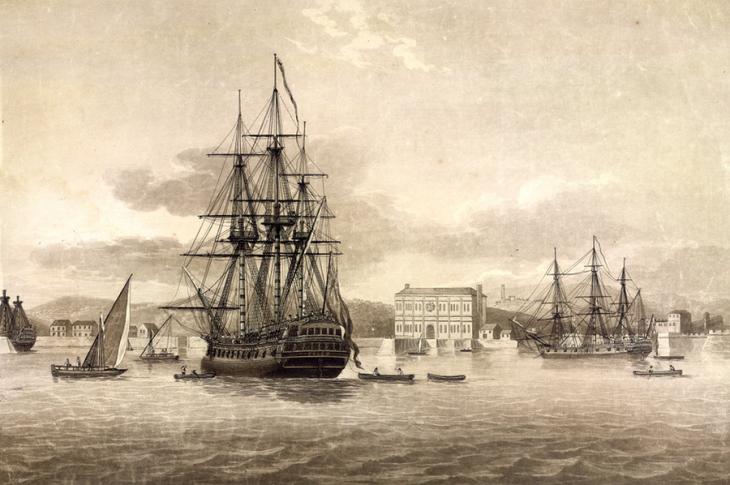
First-Rate: A method of classifying British ships, based on the number of their guns, in force from the mid-seventeenth century to the mid-nineteenth century. Ships were rated from first to sixth-rate. Any without enough guns to be sixth-rate were referred to as unrated. First, second, third, and (before 1756) fourth-rate ships were also called ‘ships of the line’, because they were considered large enough to stand in the line of battle. The exact criteria for each rate varied over time.
Frigate: In the eighteenth century, a frigate was a ship with three square-rigged masts, built for speed and often used for patrolling. The definition of a frigate varied between countries and over time, but it generally had between twenty and forty guns on a single gun-deck. Frigates were too small to be part of the line of battle, but were large enough to operate independently over a wide area. A frigate was often the largest ship available to the Commander of the Bombay Marine The navy of the East India Company. in the Persian Gulf The historical term used to describe the body of water between the Arabian Peninsula and Iran. in the nineteenth century.
Jolly boat: This term could refer to several different vessels. The normal usage was for a small, broad, clinker-built ship’s boat, measuring twelve feet long. It was propelled by oars and was normally kept at the ship’s stern. However, it could be used as a term for a Perso-Arab or Indian craft, and was also used to refer to the gallivat, which developed into the jālbūt.
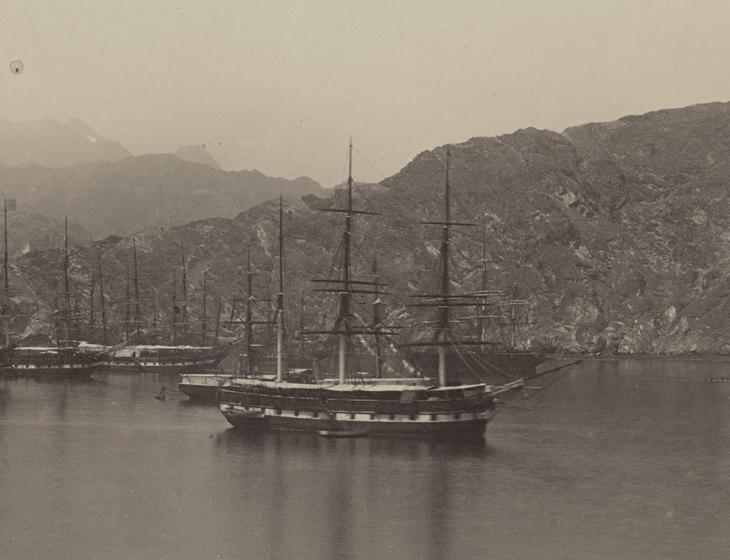
Launch: Flat-bottomed vessel used in shallow water, usually with one mast rigged fore-and-aft. This was the largest ship’s boat in the nineteenth and twentieth centuries, used for carrying stores or expeditions against small vessels or an enemy coast.
Lighter: Flat-bottomed boat used to transfer cargo to or from shore to a ship, especially one anchored in a roadstead.
Packet: This term refers to the function, rather than the type of ship. In the sixteenth and seventeenth century, packet boats were ships used for carrying packets (letters), and were owned or chartered by the government. Gradually, they began to carry some passengers and a small amount of cargo. Speed was their most essential quality.
Schooner: A fore-and-aft rigged sailing vessel with two or more masts, which developed from the sloop of war (see below) in the early eighteenth century. Schooners were small and fast, used for fighting as well as fishing and carrying cargo. The simplicity of the rig meant they needed fewer people to handle them, and allowed them to sail close to the wind.
Sloop: A small, single-masted vessel. ‘Sloop’ in British records often refers to a sloop of war.
Sloop of War: Any unrated war vessel was called a sloop of war in the eighteenth and most of the nineteenth century. These were armed with between ten and eighteen guns on one gun deck, and had two or three masts. The French equivalent was called a corvette. These ships were used in a similar manner to frigates.
Snow: Similar to the brig and brigantine, this was a two-masted, square-rigged vessel. A snow-mast or trysail mast (a smaller mast fixed to a step on the deck) was fitted immediately behind the main mast. In the early eighteenth century, snows were fitted with between five and sixteen guns, when they were used as military vessels.
_0001.jp2/full/!240,/0/default.jpg)

